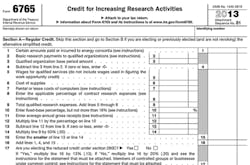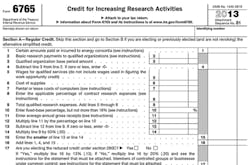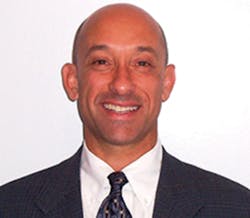A majority of plastics processors and toolmakers probably send too much money to the IRS
THIS UPDATE was provided by Mike Devereux, partner and director of manufacturing and distribution services for Mueller Prost, St. Louis, Mo. On Dec. 16, in the last vote of the 113th Congress, the U.S. Senate passed H.R. 5771, the Tax Increase Prevention Act of 2014, commonly known as "Extenders." Had the legislation not been passed, thousands of manufacturers, engineering firms, software developers and technology companies would have seen a higher tax bill for 2014. Before this legislation, the Credit for Increasing Research Activities aka the R&D or R&E tax credit, expired for expenditures paid or incurred after Dec. 31, 2013. This Extender legislation extends this important incentive for research expenditures paid or incurred through Dec. 31, 2014.
The original story ran in the November issue of Plastics Machinery Magazine.
The R&D Tax Credit is getting a lot of attention at conferences and across the industry.
In 2011, the lastest year with available IRS stats, American businesses used the Federal R&D Tax Credit to hold on to more than $9.4 billion that was due in business income tax after all their deductions had been used. Instead of sending it to the U.S. Treasury, businesses used the money saved with the R&D credit to do, well, whatever they wanted. Sadly, relatively few plastics processors were among them.
Congratulations to the plastics industry companies that claimed the R&D Tax Credit that was due them. The bad news is that, even after years of discussions, presentations, seminars and magazine articles, evidence says most plastics processors are not claiming the credit, which makes it very likely they are sending more money to the Treasury than they should. Are you one of them? Take note: This is often not pocket change.
As a general rule, capital expenditures do not qualify for this credit. But a company may be developing a new manufacturing process or improving an existing manufacturing process (which, in fact, may be the reason for the purchase of new equipment). If that's the case, the company would be entitled to claim the wages spent in the development or improvement of the manufacturing process, as well as any materials used or consumed in the development. Therefore, in this example, the company would be able to include the wages spent in the design, development, and testing of the process, as well as any materials (such as resin or fused deposition modeling material) used in the development and testing of the process.
Of the $9.4 billion claimed in 2011, the U.S. manufacturing sector claimed 64 percent of it, or $5.9 billion. Manufacturing's share has declined from 72 percent in 2006, though the dollar value of that share, of course, is greater.
It's hard to say how much of that was claimed by plastics processors.
Unfortunately, the IRS stats don't drill down past three-digit SIC codes. SIC 326 — Plastics and Rubber Products Manufacturing — sounds like it includes all plastics processors. It does not, and it would take more space than we have here to explain why. But what we do know is that SIC 326 companies that made use of the R&D credit in 2011 claimed a total of $36.6 million — 0.62 percent of the $9.4 billion total.
That 0.62 percent is not a typo. There is more to claim, especially given the statistics on the size and value of the U.S. plastics industry published by the Society of the Plastics Industry, the Washington-based plastics industry trade association. Plastics is the third-largest sector of American manufacturing. It employs more than 900,000 workers and its annual shipments are valued at $373 billion. Given that, the plastics processor and toolmaker piece of the tax credit pie is more like a sliver.
To get a handle on this glaring disconnect between potential and results we checked in with two experts on the R&D tax credit: Michael Devereux is a partner and director of manufacturing and distribution at the CPA/business advisory firm Mueller Prost PC, St. Louis; Scott Schmidt is the principal and founder of the Black Line Group, Plymouth, Minn., an R&D tax credit specialist firm.
Each has worked for years helping plastics processors and tooling companies claim the credit. In that span they have spent enough time in our shops to appreciate the magic plastics pros do every day and they speak the industry language. Black Line Group is the R&D Tax Credit affinity partner of the SPI and Mueller Prost is a sponsor of the Manufacturers Association for Plastics Processors, or MAPP.
So then, what is the reason that so few processors and toolmakers claim the credit? Devereux and Schmidt say it is reasons — plural — and they are in agreement on what they are. Not surprisingly, they all relate in one way or another to familiarity with the tax credit and to what qualifies as a claimable expense.
Things to Know
The R&D Tax Credit first appeared in the Tax Act of 1981, was changed in 1986 and 1989, and in the '90s it was modified to emphasize experimentation. The IRS then began referring to it as the Research & Experimentation or R&E Tax Credit, the title most accounting and tax professionals use today. However, at the top of IRS Form 6765, the one used to file for the credit, it is called the Credit for Increasing Research Activities. We'll use R&D Tax Credit here, as do most industry people, but remind you that experimentation and increasing research activities are important aspects of the credit.
There is understandable confusion about the credit's current status. It has never been permanent but has been extended as needed since its start, other than two six-month periods. It expired at the ends of 2009 and 2011 but later was extended retroactive to the start of the year. In September 2010, President Barack Obama proposed making the credit both more generous and permanent. It expired at the end of 2013.
As PMM went to press both Schmidt and Devereux were confident Congress would renew it following the November mid-term election as part of a tax extenders package, though it was not likely to be made permanent. SPI has been advocating for making the R&D Tax Credit permanent for several years, and today it is still one of the association's top priority issues.
A reminder about credits vs. deductions: Tax deductions are subtracted from your gross income, while tax credits offset the amount you owe in taxes. A $1,000 deduction for someone in the 25 percent tax bracket saves $250 in tax. A $1,000 tax credit lets you keep $1,000 you otherwise would pay in taxes. And the R&D credit gives you both benefits. You get to have deductions for research expenditures and a credit is a dollar-for-dollar reduction of your tax liability.
The R&D credit you can receive is not equal to your total qualifying expenses. What you will finally claim is determined by applying a calculation to the gross amount of qualified R&D. The claimed credit generally ranges from 6 percent to 10 percent of the gross amount. This still can be a significant amount. On the Black Line Group's website, Schmidt has posted a couple of examples. One is an injection molder with sales of $18 million. It claimed $390,000 through the R&D credit. A mold builder with $26 million in revenue claimed $395,000.
While keeping his client anonymous, Mueller Prost's Devereux describes the recent experience of a plastics processor in the Southeast U.S. Last year the company's qualifying wage expenses were about $580,000. (More on eligible expenses later.) Qualifying supplies expense was $2,220,000, for a $2.8 million total. After calculation, the net benefit was $160,000, nearly 6 percent.
If you are thinking, "Hey, we're a small business. We don't have near that much research expense. The only 'lab' we have is quality control." Most plastics processors and mold makers react that way.
The good news: You don't think like Congress or the IRS. The bad news: You probably don't know how "research," "development" and "experimentation" are defined by the IRS (relatively broadly). And the worst news: Your assumptions could be costing you a substantial load of dollars.
Qualifying Expenses
There are three categories of expenditure eligible for the credit. The first is wages spent doing research, supporting it or supervising it. Engineers immediately come to mind but it can also be process techs doing the experimentation, or a technical sales rep helping a client. It could be an owner of a company suggesting design improvements to a client to boost the project's design for manufacturing/assembly (DFM/DFA) or decrease cycle time for higher productivity.
The second category is supplies, anything tangible used in the experimentation process other than capital assets. This category was broadened a few years ago when an auto tier supplier won a court case that allowed it to claim the cost of molds made by a third-party toolmaker. The supplier's reasoning was that, even if the molds had been provided by the mold supplier, the tier parts maker had to work to have them make acceptable parts at the desired production volumes.
The third category is contract research, for which you can claim 65 percent of your cost from an outside firm. Those could be things like a UL rating, certification inspections, a mold-filling analysis, and wire EDM, polishing or texturing work on a mold.
There is a four-part test to see if a research activity qualifies for the R&D credit:
• The first part defines qualified research activities as development of or improvement to a business component, such as a product, process, technique, formula, invention or software.
• Second, the research must be technological in nature; the process of experimentation must rely on physical or biological sciences, engineering or computer science.
• Third, research must aim to eliminate uncertainty in development or improvement of a business component; uncertainty exists if the capability or method for developing the business component is unknown, or if the appropriate design of the business component is unknown.
• Fourth, elimination of the technical uncertainty must be accomplished through a process of experimentation, including systematic trial and error, modeling or simulation.
Continuous improvement projects can also qualify, for example, reducing cycle time. A molder wants to take a cycle from 22 seconds down to 16 seconds; that's a goal under Part 1. Technology will be used as per Part 2. It's uncertain at the start how this can be done, which fits Part 3. A number of approaches are tried, which is experimentation as called for by Part 4.
Don't Stop Before You Start
The information you see above, which was provided by Schmidt and Devereux in separate conversations, is the base needed to both men's answers to the question: Why is the plastics sector's slice of the R&D Tax Credit so small?
There is a fair amount of misleading information that makes pursuing the tax credit seem not worth the effort. Before we talk about those myths, though, the simplest explanation for why more plastics processors and toolmakers aren't benefitting from the credit is they take themselves out of the game before it starts.
Devereux and Schmidt both label the phenomenon self-censoring. It's the processor or toolmaker believing they don't do R&D because their clients provide them with a drawing, or they don't have a lab with people in white coats, rather than learning how the IRS defines it.
Both of these experts, as well as others in the field, stand ready to meet a manufacturer and do an assessment to see if there's potential for using the credit, and to be fair, sometimes there is not, or not enough, qualifying activity to justify the work needed to get it.
Others cancel themselves out by misunderstanding one or more parts of the four-part test. Part 1, having a goal of developing or improving a product, process or other business component, is usually not a problem. Part 2, that the research must be technological and experimentation must rely on physical science, engineering or computer technology is also generally not a big problem, though some will say, "We're only applying our personal experience," and go no further. One must ask if that experience is not based in what we now call the STEM (Science, Technology, Engineering, Mathematics) disciplines. Nearly always it is, and probably all four.
Part 3 of the test, which says research must aim to eliminate uncertainty in developing a business, could prove a dropout point. An experienced production engineer in an injection molding shop, for example, might feel uncomfortable with the term "uncertainty" regarding a new project. She or he has been getting new molds running well for years and is certain the same will happen with the new one. Yes, it almost certainly will, but the third test says uncertainty exists if the capability or method for developing the business component is unknown—and since the process parameters for this new mold on press number 14 is not known exactly at the start, there is uncertainty.
A skilled production engineer, using a process of experimentation that includes systematic trial and error, modeling or simulation, will develop a process that eliminates uncertainty so the mold can go into production mode. That satisfies the fourth "must" of the four-part rule, and puts you in line to keep some serious money from going to the tax man.
The Myths
Some of the more common myths about the R&D tax credit include:
It's for big corporations, not small or midsized enterprises (SME) like many processors. For tax year 2011, companies with revenues greater than $250 million claimed $7.6 billion of the total $9.6 billion R&D Tax Credit claimed. Their numbers are bigger and so are their CPA firms and internal resources. In 2011, businesses with less than $10 million in revenues claimed $591 million, of which $284 million was claimed by businesses with revenues less than $1 million. Tax credit specialists exist to work with SMEs.
It's for C corporations only, not S corps, partnerships and LLCs where shareholders who pay the tax on the corporation's income may be in the Alternative Minimum Tax (AMT) and can't use the credit. Devereux says a flow-through corporation passing out income can also pass out the credits it earned, and the tax code allows offsets of the AMT in certain circumstances.
Documentation is a burden. In any dealing with the IRS it's best to have documentation. Tax credit specialists say part of their process is creating documentation a client can follow. Personnel time records are what most people consider a heavy chore. While they are a good idea, they are not required; taxpayers can use estimates. The IRS at one time said contemporaneous time records were required but they have lost a number of court challenges on that issue. Documentation does require work, yet those companies using the R&D credit think it's worthwhile.
A Cautious Processor
Tom Duffey, president/owner of PCI-Plastic Components Inc., Germantown, Wis., says his first focused awareness of the R&D Tax Credit resulted from sitting next to Devereux eight years ago during lunch at a MAPP Benchmarking Conference. After hearing about PCI's high-tech, advanced automation business model, Devereux said the company was a very good candidate for the credit. Duffey wasn't so sure. He knew one molder who had IRS trouble over the R&D credit and spoke with another who thought it was a nightmare.
Seeing the potential and working with Devereux, they built a case for PCI using the credit. PCI's first credit claim was for 2007, when Duffey was comfortable with the credit and had the documentation that Devereux created based on PCI's work. Duffey feels strongly about the need for documentation and says that it's real work to collect the data Devereux needs to calculate the credit every year. There are binders of data and archived information.
PCI aims to be a cost-competitive provider of high-precision, complex plastic components, and that means extensive automation. Its second Germantown facility is a lights-out 24/7 production center. In late 2012, PCI opened the Engineering Resource Center, an advanced prototyping service providing clients with design — parts and tooling — development featuring in-house, rapid prototyping of production-quality parts for validation and testing.
The emphasis on development dovetails with the R&D Tax Credit, and Duffey has gone from skeptic to strong supporter.
"It's now seen by the people in D.C. as strategic, a genuine incentive to keep developing world-class technology. It takes effort to earn the credit but it's worth it, and the results are meaningful," he says.
Rob Neilley, senior correspondent



